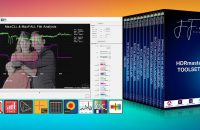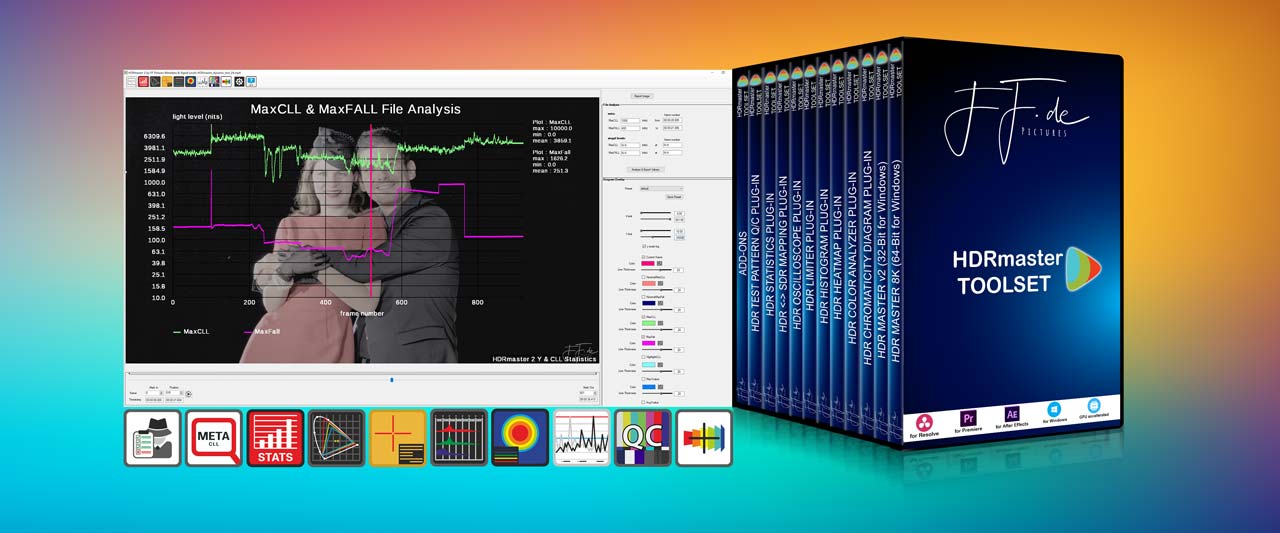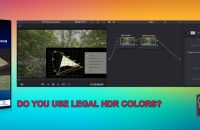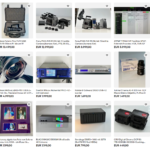QR Code Generator Plug-in
With this plugin, you’re able able to insert QR Codes into your video production. This allows viewers to visit a specific website with more information, read an additional text, link to your social media profiles and much more – you name it! Controls: Preset Section In this section, you’re able to save and open presets for this plug-in. You may store all your settings, including text color and position into one preset file. This allows you to maintain the same style across different projects. QR-Text Here you’re able to enter the text information of the QR Codes itself. This may be plain text or links or other functions. Examples: https://ff.de/qr-code-plugin -> links to this page mailto:mail@outlook.com -> starts to create an email to mail@outlook.com of course, you can do other things as well: Send money to a PayPal or bitcoin address, trigger calender events, link to your Youtube channel, Instagram Profile or […]
HDRmaster Toolset (standalone software + plug-ins)
HDRmaster Toolset This collection of products contains Standalone Windows Software and HDR-related plug-ins (for DaVinci Resolve, Adobe Premiere and Adobe After Effects). It includes the following products: HDRmaster 8K (64-Bit Windows application) HDRmaster v2 (32-Bit Windows application) HDR Chromaticity Diagram Plug-in HDR Color Analyzer Plug-in HDR Heatmap Plug-in HDR Histogram Plug-in HDR Limiter Plug-in HDR Oscilloscope Plug-in HDR SDR Mapping Plug-in HDR Statistics Plug-in HDR Test Pattern Q/C Plug-in
Software Products
FF Pictures offers various software products for immediate download after purchase. The list below includes standalone software as well as plug-ins for DaVinci Resolve, Adobe Premiere and Adobe After Effects. Most of the products are related to High Dynamic Range video production workflows, enabling colorists, editors, content providers, studios, manufacturers and other experts to analyze HDR video materials. Identifying problems and adding static or dynamic metadata works best with the HDRmaster 8K software (64-Bit, Windows), while the HDR related plugins will help you solve issues. With HDRmaster Toolset, you’ll get all of our HDR tools for one very attractive price. FF Pictures is an official adopter (content and tool provider) of the HDR 10+ Technology. You may find us listed here.
Test Pattern Q/C plug-in for Davinci Resolve, Adobe After Effects and Adobe Premiere
We are currently preparing to finish and release this plugin, please come back later…
HDRmaster 8K (standalone HDR metadata & quality analysis tool for windows)
This is a help page for HDRmaster 8K Software, which can be purchased as a single product or as part of an annual subscription in HDRmaster Toolset. Following this paragraph, you’ll find a collection of tutorial videos for the software. Adding HDR10plus to existing HDR videos for youtube or UHD-BD Analyzing MaxCLL and MaxFALL HDRmaster can analyze MaxCLL and MaxFALL values for existing video files, and file sequences. This process can be used for Quality Control of HDR productions or simply to find meaningful values for the metadata to be added.
Chromaticity Diagram Plugin for Davinci Resolve, Adobe After Effects and Adobe Premiere
With this plugin, you’re adding a the ability to monitor using a CIE diagram to your productions. It covers BT.2020, DCI-P3, BT.709 and Adobe RGB. The diagram will help you to see how much of the color gamut you’re using and if you’re exceeding the legal colors of the specified gamut. Working with the BT.2020 container in particular, it’s important to manage necessary limitations and see if you’re using legal colors or not. The plug-in will show you the xy or u’v’ coordinates of the pixels in your video! Controls: Preset Section In this section, you’re able to save and open presets for the appearance and calculation basis of this plug-in. Several presets are delivered with the installation of the plug-in. Controls: Area Selection If you want to apply the chromaticity analysis to a specific section of the frame instead of analyzing the whole frame, you’re able to do so here. […]
Measured Color Plugin for Davinci Resolve, Adobe After Effects and Adobe Premiere
We are currently preparing to finish and release this plugin, please come back later…
Spectral Reading Plugin for Davinci Resolve
Imagine you’re able to use your Minolta CS-2000 Spectroradiometer directly within Davinci Resolve and store the values. This really helps if you want to see what your grading monitor does for example. We are currently preparing to finish and release this plugin, please come back later…
Oscilloscope Plugin for Davinci Resolve, Adobe After Effects and Adobe Premiere
It’s like a measurement device directly within Resolve, Premiere or After Effects! This plugin allows you to create pixel profiles of individual lines, columns or in between cursor positions. Once you selected your area of interest, you’re able to measure signal differences with four adjustable cursors or even export the values to a CSV file for further analysis. We are currently preparing to finish and release this plugin, please come back later…
HDR Limiter Plugin for Davinci Resolve, Adobe After Effects and Adobe Premiere
When it comes to HDR for consumer electronics, video editors as well as colorists want to make sure that there’s no unnecessary information in the signal. The HDR limiter plugin checks (Q/C) for color coordinates outside the specified gamut as well as luminance levels above or below the limitations of the mastering environment. Once these limitations are exceeded, HDR limiter will either colorize these areas (so that you see where your signal clips) or simply restrict the values to the given limitations. For example: If you master your video to 1000 nits peak white and P3 gamut, why would you accept any signals outside these limits? Such signals might cause the viewer to see something you did not see while creating the content and they would add additional payload/stress to the encoder. We are currently preparing to finish and release this plugin, please come back later…





